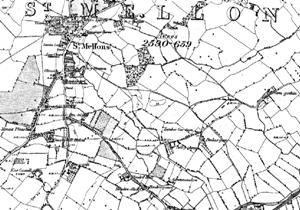THE HISTORY OF CARDIFF'S SUBURBS
OLD ST. MELLONS AND PONTPRENNAU
Incorporating the estate of St. Mellons
CONTENTS
Tap or click to open / closeEarly Origins
The area's history spans back to the time of the Silures over 2,000 years ago. Evidence of this can be found in the form of a cromlech, in the grounds of Druidstone House.
There are numerous theories over the origin of St. Mellons' name. Llaneurwg, as St. Mellons is known in Welsh, may have been named after the local chief Eurwg/Eirwg.
Eurwg was the great-great-grandson of Bran, King of Gwent and grandson of the famous Caradoc, in 180 AD. Eurwg lived on the hill at St Mellons where the church now stands.
Source: OS
Another suggestion is that Mellonius, first Bishop of Rouen in the 4th Century, was born in the area and a church was dedicated to him.
The most likely theory is that when the Normans conquered the region in the 11th Century, they dedicated a new church to St. Mellon, their patron saint.
The Norman church was completely rebuilt and extended in the 14th century, repaired again in 1868, but evidence of its mediaeval features still remain.
Cefn Mably House
Norman Conqueror of Glamorgan, Robert Fitzhamon, had a house or hunting lodge constructed for his daughter Mabel, in the area we now call Cefn Mably.
The Normans were in control of most of Cardiff until the early 13th century, when the lands and property in St. Mellons passed into the possession of the Kemys family through marriage.
Cefn Mably was set in 6,000 acres of countryside, within which roamed a large herd of deer. The house was rebuilt in the 16th Century, and an eastern wing and a new chapel were added in the 18th century.
By the late 19th Century, the house was described as one of the finest and most historic country seats in Wales. Cefn Mably was sold in 1920, and converted into a hospital until 1983.
It was almost destroyed by arson in 1994, but has been restored and converted into luxury apartments. Another fine property in the area was Quarry Hill House.
It was built sometime during the early 18th century, on top of what used to be a Roman camp used by workers who were constructing the Via Julia Maritima (now Newport Road).
Ye Olde Fayre
St. Mellons Fair was an annual event enjoyed by the populous and visitors alike, was organised by the monks of the monastery at Llanrumney.
The fair was held on 22 October, St. Mellons Day, and continued until the middle of the Reformation in 1859.
The fair was replaced by a ploughing match which evolved into the St. Mellons Show. This was held at Llanrumney Park until the modern housing estate was built, and is now a popular annual event at Tredegar House.
In 1629, a Poor House was constructed for the less affluent residents. This was converted in 1854 to a village school, which served the community until the mid 1980's, when it was replaced by a bigger, modern school in Llanrumney and subsequently demolished.
Had the school been preserved, it would have most likely been listed under a conservation scheme. By the early 19th century there were Baptist and Methodist chapels, and a choice of pubs to frequent, such as the White Hart or the Fox and Hounds.
The Creation of Pontprennau
Pontprennau used to be farm in the parish of Llanedeyrn, but in the 1970's new housing estates were built and the population rapidly grew.
St. Mellons and Pontprennau were suburbs of Cardiff by 1974 and by the 1990's the estates started to spill over the boundaries into Lisvane and Cyncoed.
The East of Pontprennau and Cardiff Gate developed quickly into a commercial hub due to it's proximity to the M4, while the South and West were devoted to the rapidly growing housing estates.
Old or New St. Mellons?
In 1977, Cardiff County Council deemed the most historically significant part of St. Mellons to be worthy of special recognition.
A new boundary was drawn up which encompassed the majority of the oldest buildings such as St John's College, the Bluebell, Kingdom Hall of Jehovah's Witnesses and the Coach House (formally White Hart).
This boundary enclosed Old St. Mellons, leaving the newer housing estate of St. Mellons to the South, and Pontprennau to the North.
PAGE UPDATE HISTORY
01 April 2024 (Content and coding updates)
01 December 2014 (Coding updates)
July 2009 (Page Created)

